Detailed explanation of python operation with excel
Prerequisite:
The modules that python needs to use to operate excel include xlrd, xlwt, and xlutils. Perform read, write and update operations on excel. When operating excel, you need to import these modules first. The demo is as follows:
excel-read operation knowledge points:
book = xlrd.open_workbook( sheet = sheet1 = book.sheet_by_name( rows = cols = row_value = sheet.row_values(2 col_values = sheet.col_values(1 cell_value = sheet.cell(8, 1 cell_str = sheet.cell(8, 1).value
excel-read excel small case:
1 import xlrd 2 ''' 3 读取excel的数据,读取数据的列固定,循环读取每行数据,读取后的数据格式如下: 4 [ 5 {'name':xxx,'sex':xxx,'id':1}, 6 {'name':xxx,'sex':xxx,'id':1}, 7 ....... 8 ] 9 '''10 def readExcel():11 try:12 #若输入的excel不存在,则打开excel报错13 book = xlrd.open_workbook('students.xlsx')14 except Exception as e:15 print('error msg:', e)16 else:17 sheet = book.sheet_by_index(0)18 #获取excel的总行数19 rows = sheet.nrows20 stu_list = []21 #循环读取每行数据,第0行是表头信息,所以从第1行读取数据22 for row in range(1, rows):23 stu = {}24 #获取第row行的第0列所有数据25 id = sheet.cell(row, 0).value26 name = sheet.cell(row, 1).value27 sex = sheet.cell(row, 2).value28 #将id、name、sex添加到字典,若元素不存在则新增,否则是更新操作29 stu['id'] = id30 stu['name'] = name31 stu['sex'] = sex32 stu_list.append(stu)33 print(stu_list)34 35 if __name__ == '__main__':36 readExcel()excel data format is as follows:
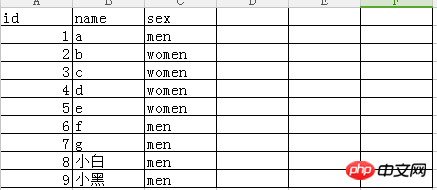
excel - writing operation knowledge points:
1 import xlwt 2 ''' 3 写 excel的操作步骤如下: 4 1. 打开excel,打开不存在的excel,若打开已存在的excel,进行写操作,写入的数据会覆盖以前的数据 5 2. 获取sheet对象并指定sheet的名称 6 3. 对excel进行操作: 7 写入excel、保存excel 8 ''' 9 #打开excel创建book对象10 book = xlwt.Workbook()11 #创建sheet指定sheet名称12 sheet = book.add_sheet('stu2')13 #写入excel数据,第n行第n列写入某个值,写入的数据类型为str14 sheet.write(0, 0, '编号')15 sheet.write(0, 1, '姓名')16 sheet.write(0, 2, '年龄')17 #保存excel,保存的后缀必须是xls18 book.save('studet.xls')excel After writing a new excel, the data format is as follows:
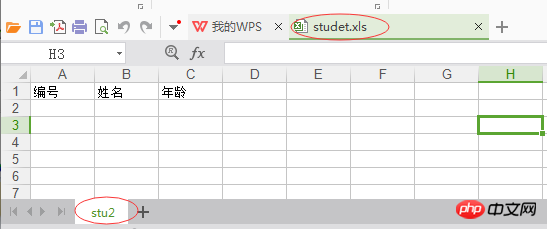
excel operates the existing excel, and the excel format after the write operation is as follows:
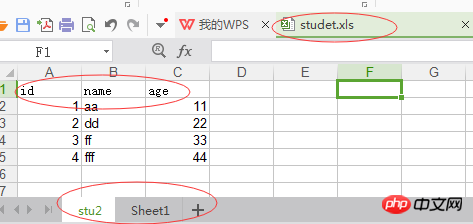 ---->
----> 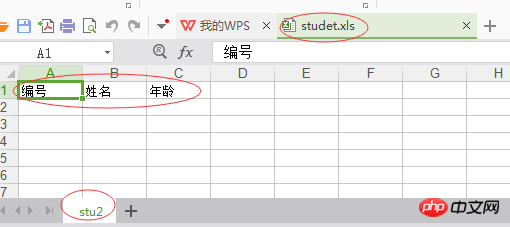
excel - Write a small excel case:
1 import xlwt 2 ''' 3 将list数据: 4 [{'name': '小白', 'id': 1.0, 'sex': '男'}, 5 {'name': '小花', 'id': 2.0, 'sex': '女'}, 6 {'name': '小黑', 'id': 3.0, 'sex': '男'}, 7 {'name': '小茹', 'id': 4.0, 'sex': '女'}, 8 {'name': '小小', 'id': 5.0, 'sex': '男'}] 9 写入excel,title信息为:编号、姓名、性别10 '''11 def writeExcel():12 book = xlwt.Workbook()13 sheet = book.add_sheet('stu')14 titles = ['编号', '姓名', '性别']15 #循环读取titles的长度,col的值为:0,1,2,并将title值写入excel16 for title_col in range(len(titles)):17 #title 写入excel的第0行的第col列,写入titles[col]值18 sheet.write(0, title_col, titles[title_col])19 students_list = [{'name': '小白', 'id': 1.0, 'sex': '男'},{'name': '小花', 'id': 2.0, 'sex': '女'},{'name': '小黑', 'id': 3.0, 'sex': '男'},{'name': '小茹', 'id': 4.0, 'sex': '女'},{'name': '小小', 'id': 5.0, 'sex': '男'}]20 for stu_row in range(len(students_list)):21 #循环读取student_list的长度,从0开始,写入excel时从第1行开始写入数据22 #写入excel的数据是从list里进行取值,获取list的每个元素,返回字典,然后通过字典的key获取value23 sheet.write(stu_row+1, 0, students_list[stu_row]['id'])24 sheet.write(stu_row+1, 1, students_list[stu_row]['name'])25 sheet.write(stu_row+1, 2, students_list[stu_row]['sex'])26 book.save('student.xls')27 if __name__ == '__main__':28 writeExcel()excel data format is as follows:
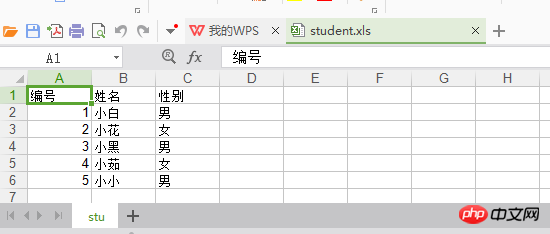
excel- Update operation knowledge points:
1 import xlrd 2 from xlutils.copy import copy 3 ''' 4 更新excel操作: 5 1. 打开excel,更新的excel必须存在 6 2. 复制一个新的excel,使用xlutils模块中的copy方法 7 3. 更新excel内的数据 8 4. 保存更新后的excel数据,以前的excel数据不会更改 9 '''10 from xlutils.copy import copy11 #打开excel12 book = xlrd.open_workbook('student.xlsx')13 #复制一个新的excel14 new_book = copy(book)15 #查看某个对象下的所有方法16 #print(dir(new_book))17 #获取新excel的sheet对象18 sheet = new_book.get_sheet(0)19 #新增一列数据20 sheet.write(0, 3, '更新')21 #更新第4行第1列的值,将其修改为'郭静',修改的数据类型为str22 sheet.write(4, 1, '郭静')23 #保存更改后的excel,以前的excel数据不更改24 new_book.save('student.xls')The above are simple excel operations~~~~
The above is the detailed content of Detailed explanation of python operation with excel. For more information, please follow other related articles on the PHP Chinese website!

Hot AI Tools

Undresser.AI Undress
AI-powered app for creating realistic nude photos

AI Clothes Remover
Online AI tool for removing clothes from photos.

Undress AI Tool
Undress images for free

Clothoff.io
AI clothes remover

Video Face Swap
Swap faces in any video effortlessly with our completely free AI face swap tool!

Hot Article

Hot Tools

Notepad++7.3.1
Easy-to-use and free code editor

SublimeText3 Chinese version
Chinese version, very easy to use

Zend Studio 13.0.1
Powerful PHP integrated development environment

Dreamweaver CS6
Visual web development tools

SublimeText3 Mac version
God-level code editing software (SublimeText3)

Hot Topics
 1386
1386
 52
52
 Can visual studio code be used in python
Apr 15, 2025 pm 08:18 PM
Can visual studio code be used in python
Apr 15, 2025 pm 08:18 PM
VS Code can be used to write Python and provides many features that make it an ideal tool for developing Python applications. It allows users to: install Python extensions to get functions such as code completion, syntax highlighting, and debugging. Use the debugger to track code step by step, find and fix errors. Integrate Git for version control. Use code formatting tools to maintain code consistency. Use the Linting tool to spot potential problems ahead of time.
 How to run programs in terminal vscode
Apr 15, 2025 pm 06:42 PM
How to run programs in terminal vscode
Apr 15, 2025 pm 06:42 PM
In VS Code, you can run the program in the terminal through the following steps: Prepare the code and open the integrated terminal to ensure that the code directory is consistent with the terminal working directory. Select the run command according to the programming language (such as Python's python your_file_name.py) to check whether it runs successfully and resolve errors. Use the debugger to improve debugging efficiency.
 Can vs code run in Windows 8
Apr 15, 2025 pm 07:24 PM
Can vs code run in Windows 8
Apr 15, 2025 pm 07:24 PM
VS Code can run on Windows 8, but the experience may not be great. First make sure the system has been updated to the latest patch, then download the VS Code installation package that matches the system architecture and install it as prompted. After installation, be aware that some extensions may be incompatible with Windows 8 and need to look for alternative extensions or use newer Windows systems in a virtual machine. Install the necessary extensions to check whether they work properly. Although VS Code is feasible on Windows 8, it is recommended to upgrade to a newer Windows system for a better development experience and security.
 Is the vscode extension malicious?
Apr 15, 2025 pm 07:57 PM
Is the vscode extension malicious?
Apr 15, 2025 pm 07:57 PM
VS Code extensions pose malicious risks, such as hiding malicious code, exploiting vulnerabilities, and masturbating as legitimate extensions. Methods to identify malicious extensions include: checking publishers, reading comments, checking code, and installing with caution. Security measures also include: security awareness, good habits, regular updates and antivirus software.
 What is vscode What is vscode for?
Apr 15, 2025 pm 06:45 PM
What is vscode What is vscode for?
Apr 15, 2025 pm 06:45 PM
VS Code is the full name Visual Studio Code, which is a free and open source cross-platform code editor and development environment developed by Microsoft. It supports a wide range of programming languages and provides syntax highlighting, code automatic completion, code snippets and smart prompts to improve development efficiency. Through a rich extension ecosystem, users can add extensions to specific needs and languages, such as debuggers, code formatting tools, and Git integrations. VS Code also includes an intuitive debugger that helps quickly find and resolve bugs in your code.
 Python: Automation, Scripting, and Task Management
Apr 16, 2025 am 12:14 AM
Python: Automation, Scripting, and Task Management
Apr 16, 2025 am 12:14 AM
Python excels in automation, scripting, and task management. 1) Automation: File backup is realized through standard libraries such as os and shutil. 2) Script writing: Use the psutil library to monitor system resources. 3) Task management: Use the schedule library to schedule tasks. Python's ease of use and rich library support makes it the preferred tool in these areas.
 Can visual studio code run python
Apr 15, 2025 pm 08:00 PM
Can visual studio code run python
Apr 15, 2025 pm 08:00 PM
VS Code not only can run Python, but also provides powerful functions, including: automatically identifying Python files after installing Python extensions, providing functions such as code completion, syntax highlighting, and debugging. Relying on the installed Python environment, extensions act as bridge connection editing and Python environment. The debugging functions include setting breakpoints, step-by-step debugging, viewing variable values, and improving debugging efficiency. The integrated terminal supports running complex commands such as unit testing and package management. Supports extended configuration and enhances features such as code formatting, analysis and version control.
 Can vs code run python
Apr 15, 2025 pm 08:21 PM
Can vs code run python
Apr 15, 2025 pm 08:21 PM
Yes, VS Code can run Python code. To run Python efficiently in VS Code, complete the following steps: Install the Python interpreter and configure environment variables. Install the Python extension in VS Code. Run Python code in VS Code's terminal via the command line. Use VS Code's debugging capabilities and code formatting to improve development efficiency. Adopt good programming habits and use performance analysis tools to optimize code performance.




